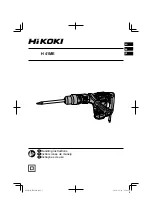
13
•Si el funcionamiento de una herramienta eléctrica en un lugar húmedo es inevitable, utilice un suministro
protegido del dispositivo de corriente residual (RCD). El uso de un RCD reduce el riesgo de choque eléctrico.
Seguridad personal
•Manténgase alerta, observe lo que está haciendo y utilice el sentido común cuando opere una herramienta
eléctrica. No utilice una herramienta eléctrica bajo la influencia de drogas, alcohol o medicamentos. Un momento
de falta de atención mientras se operan las herramientas eléctricas puede resultar en lesiones personales graves.
•Utilice equipo de seguridad. Siempre use protección ocular. Los equipos de seguridad como la mascarilla contra
el polvo, los zapatos de seguridad antideslizante, el casco o la protección auditiva que se utilicen siempre que las
condiciones requieran reducirán las lesiones personales.
•Evite el arranque accidental. Asegúrese de que el interruptor esté en la posición de apagado antes de enchufarlo.
Llevar las herramientas eléctricas con el dedo en el interruptor o enchufar las herramientas eléctricas que tienen
el interruptor encendido invita a accidentes.
•Mantenga los pies y el equilibrio adecuados en todo momento. Esto permite un mejor control de la herramienta
eléctrica en situaciones inesperadas.
Uso y cuidado de la herramienta electrica
• No fuerce la herramienta eléctrica. Utilice la herramienta eléctrica correcta para su aplicación. La herramienta
eléctrica correcta hará el trabajo mejor y más seguro a la velocidad para la que fue diseñada.
•No utilice la herramienta eléctrica si el interruptor no lo enciende y apaga. Cualquier herramienta eléctrica que
no pueda controlarse con el interruptor es peligrosa y debe ser reparada.
•Desconecte el enchufe de la fuente de alimentación antes de realizar cualquier ajuste, cambiar accesorios o
almacenar herramientas eléctricas. Tales medidas preventivas de seguridad reducen el riesgo de arrancar la
herramienta eléctrica accidentalmente.
•Almacene la herramienta eléctrica inactiva fuera del alcance de los niños y no permita que las personas que no
estén familiarizadas con la herramienta eléctrica de estas instrucciones operen la herramienta eléctrica. Las
herramientas eléctricas son peligrosas en manos de usuarios no entrenados.
•Mantenga las herramientas eléctricas. Compruebe la desalineación o el pegado de las piezas móviles, la rotura de
las piezas y otras condiciones que puedan afectar al funcionamiento de la herramienta eléctrica. Si está dañada,
tenga la herramienta eléctrica reparada antes de usarla. Muchos accidentes son causados por herramientas
eléctricas mal mantenidas.
.
Servicio
• Tenga su herramienta eléctrica atendida por una persona de reparaciones calificada usando solamente piezas de
repuesto idénticas. Esto garantizará que se mantenga la seguridad de la herramienta eléctrica.
GB - General power tool safety warnings
Read all safety warnings and all instructions. Failure to follow all warnings and instructions may result in electric
shock, fire and/or serious injury. Save all warnings and instructions for future reference. The term “power tool” in
the warnings refers to your mains operated (corded) power tool or battery operated (cordless) power tool.
Work area
•Keep work area clean and well lit. Cluttered and dark areas invite accidents.
•Do not operate power tools in explosive atmospheres, such as in the presence of flammable liquids, gases or dust.
•Power tools create sparks which may ignite the dust or fumes.
•Keep children and bystanders away while operating a power tool. Distractions can cause you to lose control.
Electrical safety
•Power tool plugs must match the outlet. Never modify the plug in any way. Do not use any adapter plugs with
earthed (grounded) power tools. Unmodified plugs and matching outlets will reduce risk of electric shock.
•Avoid body contract with earthed or grounded surfaces such as pipes, radiators, ranges and refrigerators. There is
an increased risk of electric shock if your body is earthed or grounded.
•Do not expose power tools to rain or wet conditions. Water entering a power tool will increase the risk of electric
shock.
•Do not abuse the cord. Never use the cord for carrying, pulling or unplugging the power tool. Keep cord away
from heat, oil, sharp edges or moving parts. Damaged or entangled cords increase the risk of electric shock.
•When operating a power tool outdoors, use an extension cord suitable for outdoor use. Use of a cord suitable for
outdoor use reduces the risk of electric shock.
•If operating a power tool on a damp location is unavoidable, use a residual current device (RCD) protected supply.
Use of an RCD reduces the risk of electric shock.
Personal safety
•Stay alert, watch what you are doing and use common sense when operating a power tool. Do not use a power
tool while you are tried or under the influence of drugs, alcohol or medication. A moment of inattention while
operating power tools may result in serious personal injury.
•Use safety equipment. Always wear eye protection. Safety equipment such as dust mask, non-skid safety shoes,
hand hat, or hearing protection used whenever conditions require will reduce personal injuries.
•Avoid accidental starting. Ensure the switch is in the off position before plugging in.
Carrying power tools with your finger on the switch or plugging in power tools that have the switch on invites
accidents.
•Remove any adjusting key or wrench before turning the power tool on. A wrench or a key left attached to a
rotating part of the power tool may result in personal injury.
•Do not overreach. Keep proper footing and balance at all times. This enables better control of the power tool in
unexpected situations.
•Dress properly. Do not wear loose clothing or jewellery. Keep your hair, clothing and gloves away from moving
parts. Loose clothes, jewellery or long hair can be caught in moving parts.
Power tool use and care
•Do not force the power tool. Use the correct power tool for your application. The correct power tool will do the
job better and safer at the rate of which it was designed.
•Do not use the power tool if the switch does not turn it on and off. Any power tool that cannot be controlled with
the switch is dangerous and must be repaired.




































